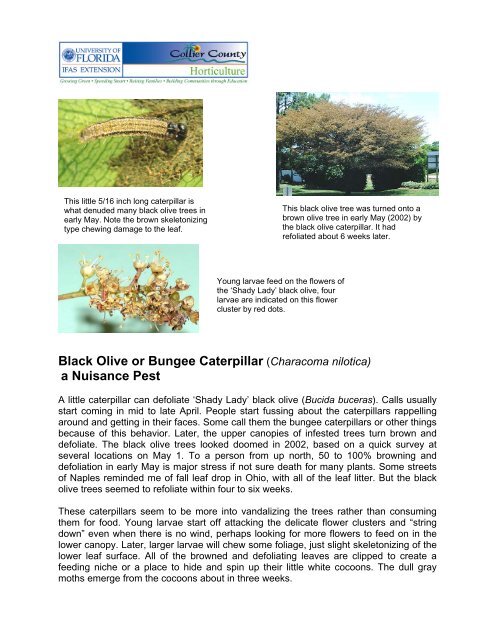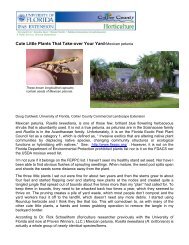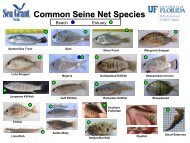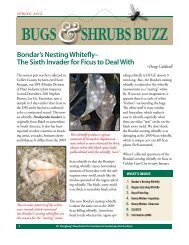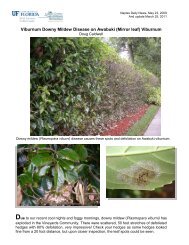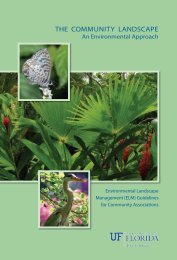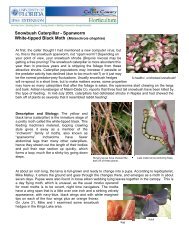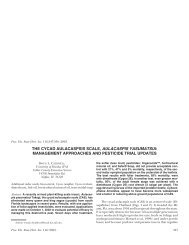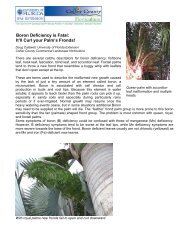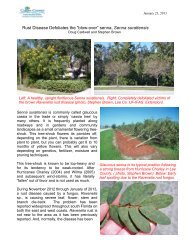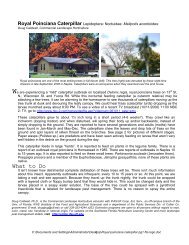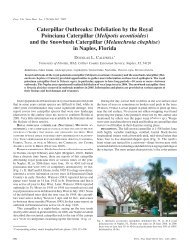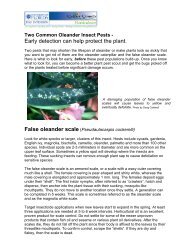Black Olive or Bungee Caterpillar - Collier County Extension Office ...
Black Olive or Bungee Caterpillar - Collier County Extension Office ...
Black Olive or Bungee Caterpillar - Collier County Extension Office ...
Create successful ePaper yourself
Turn your PDF publications into a flip-book with our unique Google optimized e-Paper software.
This little 5/16 inch long caterpillar is<br />
what denuded many black olive trees in<br />
early May. Note the brown skeletonizing<br />
type chewing damage to the leaf.<br />
Young larvae feed on the flowers of<br />
the ‘Shady Lady’ black olive, four<br />
larvae are indicated on this flower<br />
cluster by red dots.<br />
This black olive tree was turned onto a<br />
brown olive tree in early May (2002) by<br />
the black olive caterpillar. It had<br />
refoliated about 6 weeks later.<br />
<strong>Black</strong> <strong>Olive</strong> <strong>or</strong> <strong>Bungee</strong> <strong>Caterpillar</strong> (Characoma nilotica)<br />
a Nuisance Pest<br />
A little caterpillar can defoliate ‘Shady Lady’ black olive (Bucida buceras). Calls usually<br />
start coming in mid to late April. People start fussing about the caterpillars rappelling<br />
around and getting in their faces. Some call them the bungee caterpillars <strong>or</strong> other things<br />
because of this behavi<strong>or</strong>. Later, the upper canopies of infested trees turn brown and<br />
defoliate. The black olive trees looked doomed in 2002, based on a quick survey at<br />
several locations on May 1. To a person from up n<strong>or</strong>th, 50 to 100% browning and<br />
defoliation in early May is maj<strong>or</strong> stress if not sure death f<strong>or</strong> many plants. Some streets<br />
of Naples reminded me of fall leaf drop in Ohio, with all of the leaf litter. But the black<br />
olive trees seemed to refoliate within four to six weeks.<br />
These caterpillars seem to be m<strong>or</strong>e into vandalizing the trees rather than consuming<br />
them f<strong>or</strong> food. Young larvae start off attacking the delicate flower clusters and “string<br />
down” even when there is no wind, perhaps looking f<strong>or</strong> m<strong>or</strong>e flowers to feed on in the<br />
lower canopy. Later, larger larvae will chew some foliage, just slight skeletonizing of the<br />
lower leaf surface. All of the browned and defoliating leaves are clipped to create a<br />
feeding niche <strong>or</strong> a place to hide and spin up their little white cocoons. The dull gray<br />
moths emerge from the cocoons about in three weeks.
Not much inf<strong>or</strong>mation is available on the behavi<strong>or</strong> of this moth. The eggs are probably<br />
deposited on twigs in the upper canopy that hatch next spring. The local experts say<br />
that there is only one damage period and that there won’t be another generation of<br />
these little vandals. It is rather unusual f<strong>or</strong> insects down here to only have one<br />
generation. Unless the tree has been struggling from po<strong>or</strong> soil <strong>or</strong> lack of water,<br />
management attempts seem to be unwarranted. Keep a close eye on these defoliated<br />
trees as b<strong>or</strong>ers may attack, when trees are in a weakened condition.<br />
Applications of pesticides would have to be applied while the caterpillars are small,<br />
probably when the trees first start to flower, say sometime in the first two weeks of April.<br />
If they are caught early in their rappelling activity, the cosmetic damage could be<br />
minimized. However these these little caterpillars are usually not noticed until the<br />
damage has been done and it is too late to spray. A product with B.t. <strong>or</strong> spinosad as the<br />
active ingredients would be the “soft” pesticide product of choice. If the larvae are<br />
larger, Talstar (bifinthrin) will provide quick knock-down.<br />
Attention landscape architects! Because of the caterpillars and the dark rusty<br />
staining of the fruit, this tree should not be planted in parking lots <strong>or</strong> near<br />
buildings <strong>or</strong> sidewalks.<br />
Doug Caldwell, Ph.D. Commercial Landscape H<strong>or</strong>ticulture <strong>Extension</strong> Educat<strong>or</strong> with the University of<br />
Fl<strong>or</strong>ida <strong>Collier</strong> <strong>County</strong> <strong>Extension</strong>. The <strong>Extension</strong> Service is an off-campus branch of the University of<br />
Fl<strong>or</strong>ida, Institute of the Food and Agricultural Sciences and a department of the Public Services Division<br />
of <strong>Collier</strong> <strong>County</strong> government. E-Mail dlcaldwell@ifas.ufl.edu ; call (239) 353-4244 ext. 203. <strong>Extension</strong><br />
programs are open to all persons without regard to race, col<strong>or</strong>, creed, sex handicap <strong>or</strong> national <strong>or</strong>igin.


